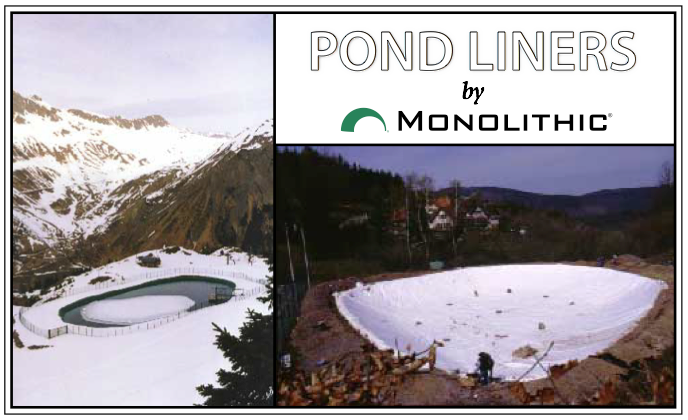Pond Liners
How do you keep water in a pond, canal or reservoir from seeping away? Or, how do you keep contaminants such as oil, industrial chemicals, even arsenic from seeping into the underground water?
“Pond liners are the answer – provided they are made of quality material and manufactured and installed properly,” says David South, president of Monolithic.
David points out that Monolithic Airforms, one of the company’s divisions, manufactures pond liners using reinforced PVC (polyvinyl chloride) geomembranes*, in virtually any size and thickness needed.
In fact, Monolithic can make a one-piece liner that measures 200′ × 400′ or 80,000 square feet. Even larger pieces are not a problem with the dielectric welding process Monolithic uses.
“We have a factory that’s 240′ × 60′ and a state-of-the-art, 200’ RF (Radio Frequency) welder that makes the manufacture of large, high quality liners possible. We concentrate on the heavy duty supported (reinforced) liners.” David says.
As for thickness, Monolithic commonly uses thicknesses ranging from 22 mil to 48 mil. That exceeds U.S. Bureau of Reclamation standards, as reported in PGI Technical Bulletin 1197.
PGI describes itself as “a non-profit trade organization dedicated to advancing the use of PVC through education and research.”
In its March 1996 Bulletin, PGI states, in part, “Although, for many years, the Bureau used .25-mm (10 mil), the currently recommended geomembrane for standard buried canal applications is 0.50-mm (20-mil) thick PVC.”
David says, “Usually, the thicker the membrane the better it will withstand aging. Thicker membranes can also better resist tears and punctures.”
That same PGI Bulletin, partly quoted here, agrees:
Buried PVC geomembranes are providing satisfactory seepage control in Reclamation canals, dams, and reservoirs. These linings are viable alternatives to concrete and compacted earth linings.
The rate of aging (plasticizer loss) of PVC geomembranes depends primarily on the following factors:
PVC geomembrane source – 56-day laboratory volatility tests indicate differences in plasticizer loss rates among PVC linings from different manufacturers.
Thickness of PVC membrane – Results of 56-day laboratory volatility tests also indicate that the plasticizer loss rates generally decrease with an increase in geomembrane thickness.
In addition to being available in a variety of sizes and weights, Monolithic’s supported pond liners are highly resistant to tears, punctures and ultra-violet damage; they are nonporous; safe for fish and plants; flexible; easy to ship and install.
For more information, contact Monolithic: [email protected] or 972-483-7423.
Updated February 2013
*Geomembrane is a coined word that relates to a number of products or materials in contact with or buried in the ground.

